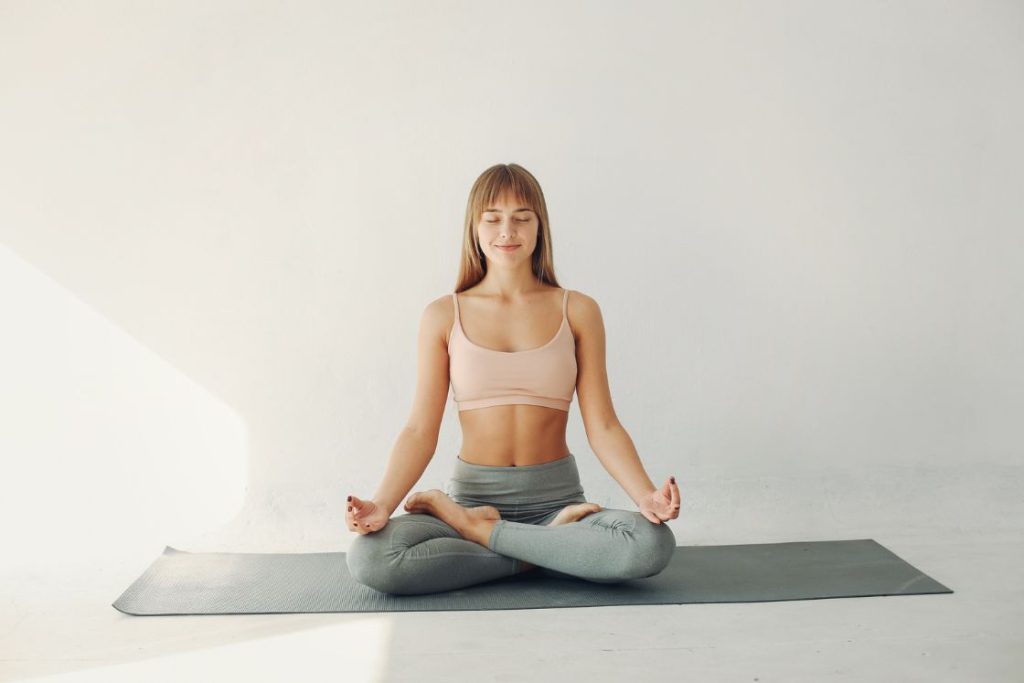
Know how yoga can lengthen telomeres length and provide anti-aging benefits. Get yogic tips on what you could do to reverse your cellular aging, look younger, and stay fitter!
The quest for the fountain of youth has spanned centuries, with people globally seeking remedies to keep aging at bay. But what if the secret to a youthful glow and vitality lies not in lotions or magic potions, but in an age-old practice? That’s where yoga comes in. Recent studies suggest that yoga has the potential to affect our genetic makeup, particularly telomeres.
These are protective caps at the end of our DNA strands, whose length plays a crucial role in aging. The longer they remain, the slower we age at a cellular level. With each passing year, our telomeres shorten, leading to cell aging and all the physical signs associated with growing older. Excitingly, Yoga could offer a natural way to keep these telomeres long and robust. So when you roll out your yoga mat, be aware that you’re not only stretching your body, but potentially adding years to your life. Dive in and discover how yoga can be your newest anti-aging ally!
How Lengthening Telomeres Leads to Anti-Aging Benefits
The anti-aging benefits of yoga are no longer just speculation, but research-based conclusions. For example, a study by professors in the physiology department of Narayana Medical College found that telomere length in leukocytes is better preserved in people who practice yoga regularly.
Another study published by doctors from the Department of Anatomy and Department of Biochemistry at AIIMS Raipur came to similar conclusions, highlighting that regular practice of asanas, pranayama and meditation can lead to telomere stability.
It’s amazing how a practice as ancient as yoga can have an impact on modern science and our understanding of aging. Within our cells are telomeres, tiny protective ends of our DNA strands that play a crucial role in the aging process. As we delve into this topic, we’ll explore the direct link between yoga, telomere length, cellular aging, and overall anti-aging benefits.
1. Regular Practice of Yoga Lengthens Telomeres:
When we think of yoga, flexibility, relaxation and stress relief may come to mind. But there is an unseen but significant change at the cellular level. The continued practise of yoga has shown a promising correlation with the preservation of telomere length. These protective caps undergo natural wear and tear over time, leading to their shortening. However, yoga, with its combined benefits of exercise, focused breathing and meditation, has been shown to mitigate this shortening. By reducing stress and inflammation — two major factors in telomere shortening — yoga provides a supportive environment in which these critical DNA caps can remain intact longer.
2. Telomeres Lengthening Delays Cellular Aging:
It’s not just about the length; it’s about the health of our cells. Telomeres serve as protective buffers, ensuring the DNA within our cells remains undamaged and functions efficiently. When telomeres are longer, they offer better protection, meaning our cells age at a slower rate. By maintaining telomere length, we essentially boost the lifespan of our cells. Engaging in practices like yoga offers a proactive approach to ensure this shield remains strong and resilient, warding off premature cellular aging.
3. Delayed Cellular Aging Leads to Anti-Aging Benefits:
Beyond the microscopic realm of our cells, the benefits of delayed cellular aging are far-reaching and clearly evident. Imagine skin that retains its firmness, joints that remain supple, and energy levels that remain consistently high. These are just some of the benefits we reap when cellular aging slows down. When we ensure that our cells stay young and function optimally, we have a direct impact on our external appearance and overall health. In short, when we take care of the health of our cells, we create the conditions for a dynamic, energetic and youthful life.
In summary, yoga not only provides a peaceful retreat for the mind and spirit, but also has profound, science-based benefits for the body. Yoga could be the key to a longer, healthier and more youthful life.
The Anti-aging Benefits of Yoga are Multi-Faceted
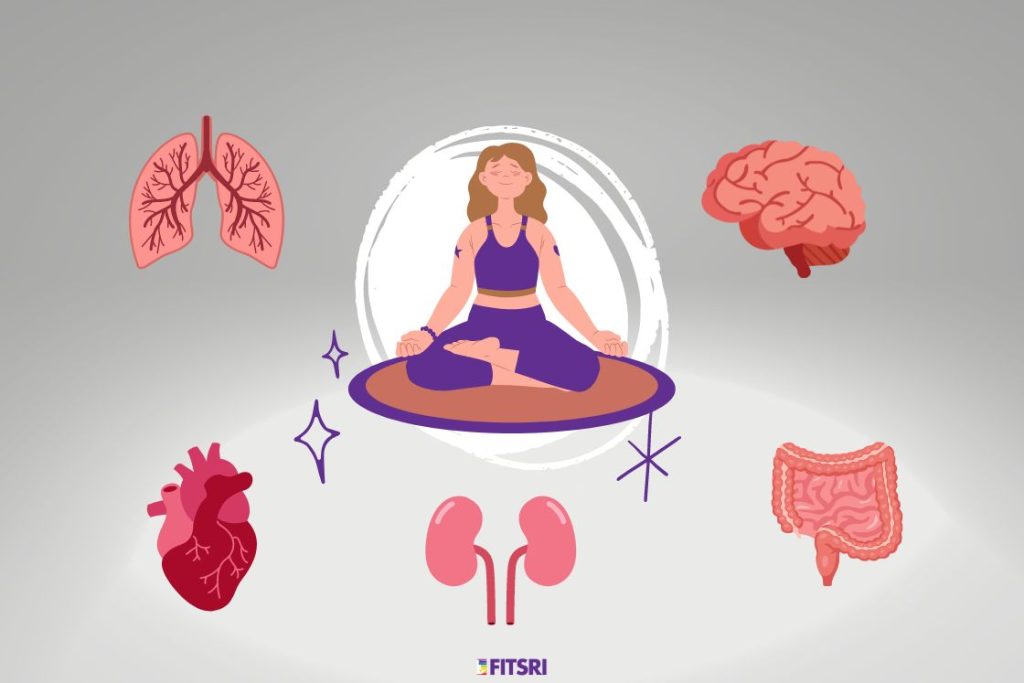
The idea that yoga can affect cellular aging is based on research that has examined the physiological and psychological benefits of yoga and its potential effects on various biomarkers associated with aging. You can find an in-depth study on this topic here:
- Stress Reduction and Cortisol:
Chronic stress is recognized as a significant factor contributing to cellular aging. Yoga practices, including asanas (postures) and meditation, have been shown to reduce psychological stress and decrease levels of the stress hormone cortisol. Elevated cortisol levels over prolonged periods can result in cellular damage, inflammation, and other deleterious effects.
- Telomere Length:
Some studies have shown that individuals who practice yoga and meditation have longer telomeres compared to those who don’t. As we discussed earlier, shorter telomeres are associated with cellular aging. The exact mechanisms through which yoga might preserve telomere length aren’t entirely clear, but reduced oxidative stress and reduced psychological stress (both of which can accelerate telomere shortening) are potential factors.
- Reduced Inflammation:
Chronic inflammation is associated with a host of age-related diseases, including heart disease, diabetes, and neurodegenerative disorders. Several studies suggest that yoga and meditation can downregulate genes linked with inflammation and can lower levels of pro-inflammatory cytokines.
- Oxidative Stress:
Oxidative stress occurs due to an imbalance between free radicals and the body’s ability to counteract or detoxify their harmful effects with antioxidants. Oxidative stress can damage DNA, proteins, and lipids in cells, thus contributing to cellular aging. Yoga has been suggested to enhance antioxidant status and reduce oxidative stress, although the evidence is preliminary.
- Mitochondrial Function:
Mitochondria are the energy powerhouses of cells, and their dysfunction is associated with aging and many age-related diseases. Some research indicates that practices associated with yoga might improve mitochondrial function, although the mechanisms are not fully understood.
- Neuroplasticity:
Chronic stress, anxiety, and depression have been linked to negative changes in brain structure and function. Yoga and meditation have been shown to promote neuroplasticity, which is the brain’s ability to reorganize and form new neural connections. This could have implications for cognitive aging.
- Hormonal Balance:
Some studies suggest that yoga can help balance various hormones, not just cortisol. Balanced hormones can lead to improved overall cellular function, reduced stress on cells, and a slower aging process.
- Improved Circulation:
The various asanas in yoga promote better blood flow, ensuring that nutrients and oxygen reach every corner of the body. Improved circulation aids in cell regeneration and removal of toxins, both of which are crucial for a youthful appearance and vitality.
- Physical Strength and Flexibility:
Yoga encompasses a range of postures and movements designed to enhance muscle strength and flexibility. Regular practice can combat the natural decline in muscle mass and bone density that occurs with age, helping maintain a youthful posture and fluidity in movements.
- Digestive Health:
Specific yoga postures aid in better digestion and absorption of nutrients. Proper nutrition at the cellular level is vital for delaying signs of aging and ensuring the body remains nourished and rejuvenated.
- Cellular Rejuvenation:
Regular yoga practice boosts the immune system and promotes cellular health. With improved immune function, the body becomes efficient in repairing and regenerating cells, slowing down the aging process.
- Psychological Benefits:
Apart from cellular and physiological changes, the psychological benefits of yoga, including improved mood, reduced anxiety, and enhanced well-being, can indirectly contribute to healthier aging by promoting better lifestyle choices and reducing behaviors that accelerate aging.
Yoga Can also Make You Look Younger
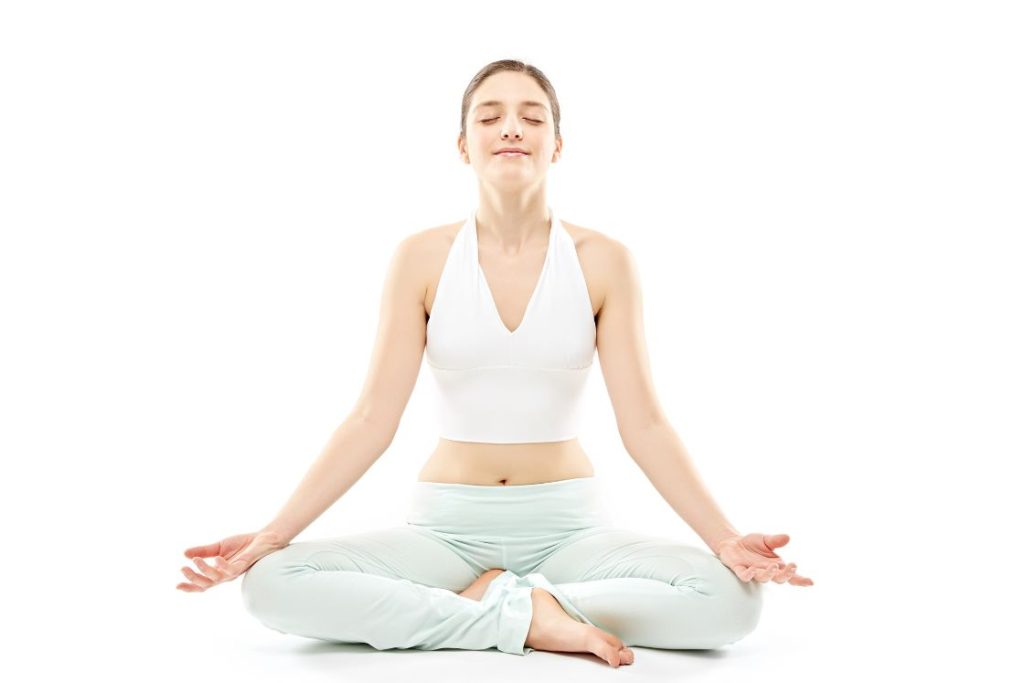
While yoga’s benefits for the mind and spirit are well-celebrated, its impact on our physical appearance, especially in making us look younger, is equally compelling. Let’s find out how this ancient practice contributes to a youthful appearance, boundless energy, and a clear, stress-free mind.
1. Yoga Rejuvenates Your Skin Health:
Radiant skin is a telltale sign of good health and youth. By enhancing blood circulation, yoga ensures that skin cells receive more oxygen, resulting in healthier, glowing skin. The increased blood flow also aids in flushing out toxins from the system, reducing the occurrence of pimples, acne, and dullness. With consistent practice, yoga can contribute to smoother, clearer, and more vibrant skin, making you look fresher and younger.
2. Yoga Revitalizes Your Energy Levels:
When we feel energized, it can make a big difference in our overall appearance. Yoga sequences, especially those that involve inversion poses or flowing movements, can give an instant energy boost. They help clear blockages and ensure the uninterrupted flow of life force or ‘prana’ in the body. When you’re bursting with energy, it’s reflected in your posture, gait and aura. An energetic appearance naturally radiates youth and vitality.
3. Yoga Frees Your Mind of Stress and Toxicity:
It’s no secret that stress can take a toll on our appearance, manifesting in the form of wrinkles, frown lines, and a perpetually tired look. Yoga’s meditative aspects, combined with deep breathing exercises, act as a detox for the mind. By clearing away mental clutter and reducing stress levels, yoga helps in achieving a serene expression and a clearer, brighter gaze.
In essence, while yoga’s internal benefits are profound, its external rewards are just as remarkable. By dedicating a few moments each day to this practice, you’re not only nurturing your inner self but also investing in a fresher, younger-looking you.
Yoga Poses that Have Proven Anti-Aging Benefits
Yoga, with its deep roots in holistic well-being, offers a plethora of poses that can bestow upon practitioners both inner vitality and outer radiance. Let’s explore some of these yoga poses that come with proven anti-aging benefits.
1. Downward Facing Dog (Adho Mukha Svanasana)
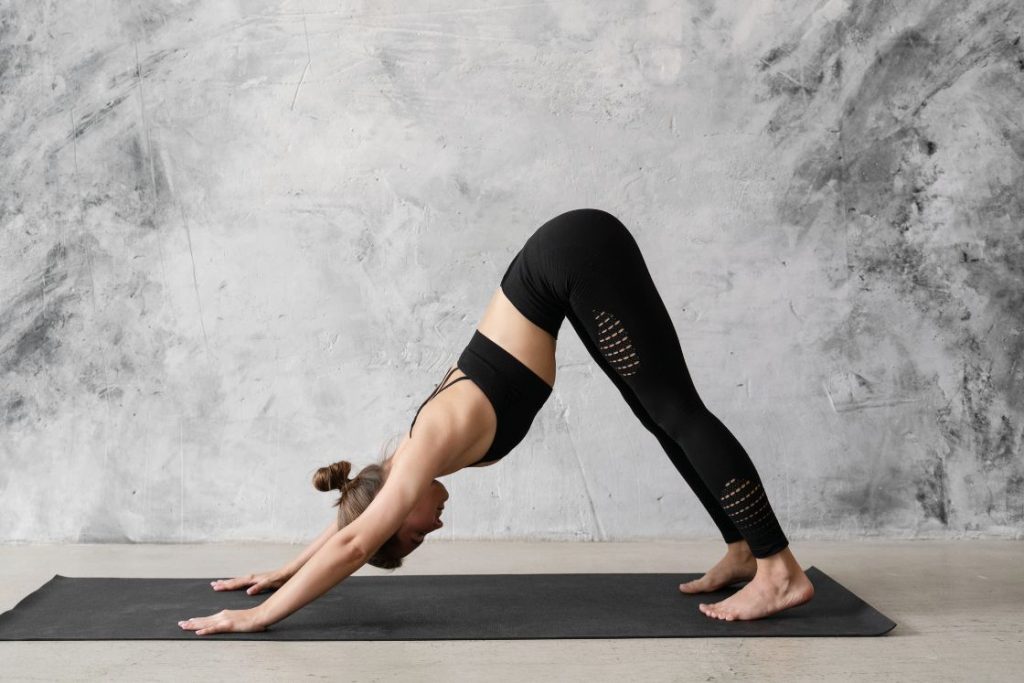
This invigorating pose stretches the entire body while promoting better circulation. It allows oxygen-rich blood to flow to the face, which can rejuvenate skin cells and impart a youthful glow. Moreover, it strengthens the arms, legs, and core, promoting overall vitality.
2. Tree Pose (Vrikshasana)
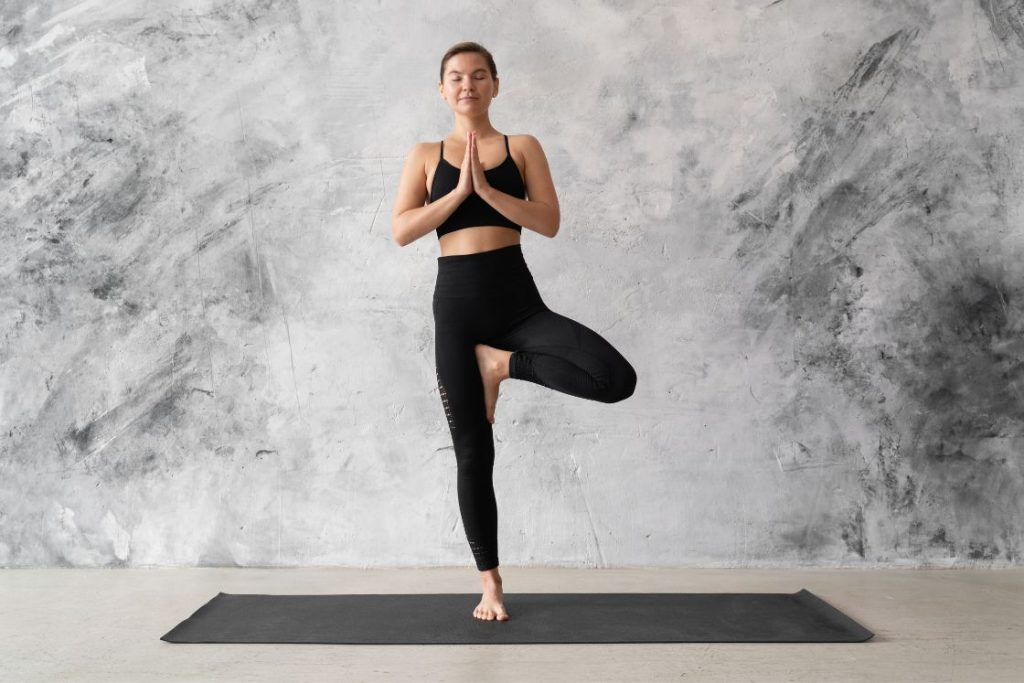
A pose of stillness and balance, Tree Pose strengthens the legs and core. It promotes good posture, a vital component of a youthful appearance. The concentration required for this pose also sharpens mental acuity, keeping the mind young.
3. Child’s Pose (Balasana)
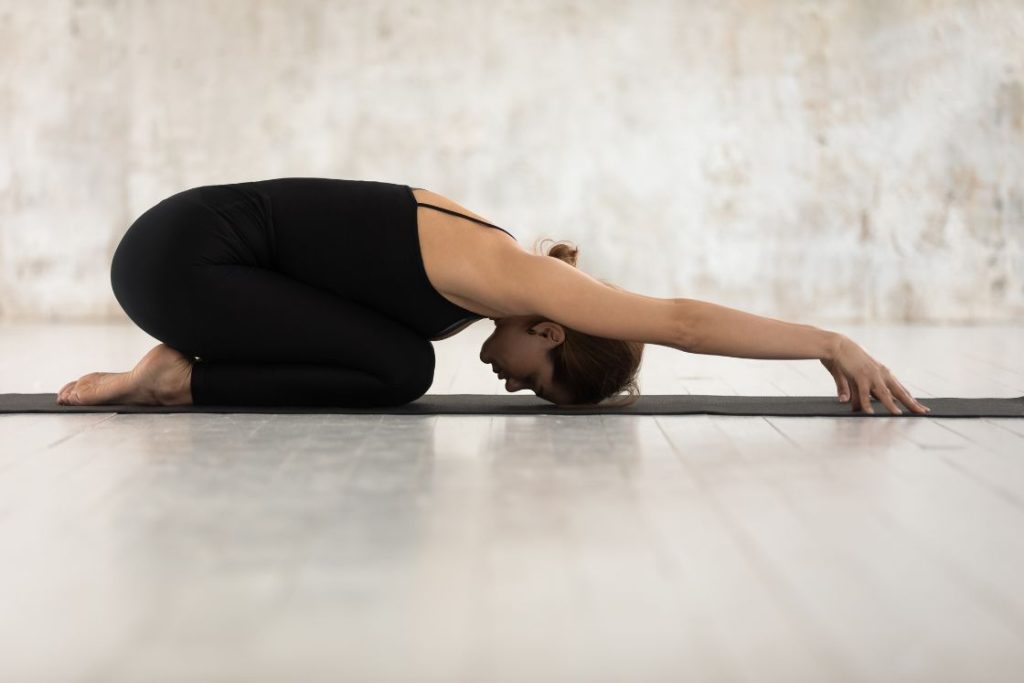
This restorative pose relieves tension in the back, neck, and shoulders. The forward bend also aids in calming the mind, reducing stress, which is a significant factor in premature aging.
4. Cobra Pose (Bhujangasana)
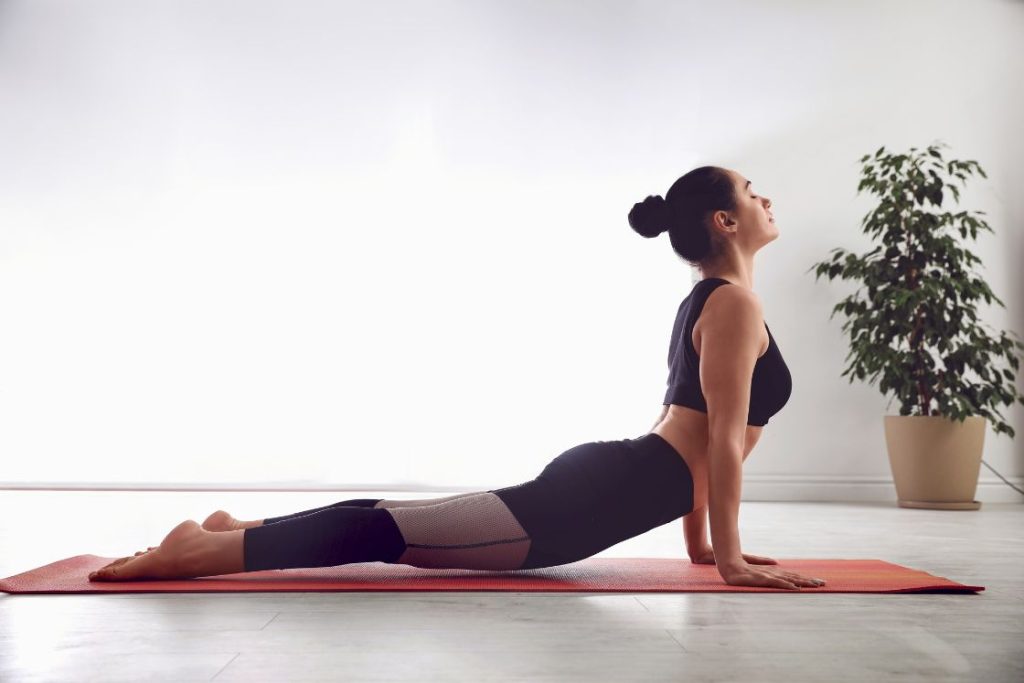
Cobra Pose opens up the chest and strengthens the spine. It improves lung capacity, ensuring cells receive ample oxygen. Furthermore, the gentle backbend can stimulate the digestive system, promoting efficient nutrient absorption.
5. Plow Pose (Halasana)
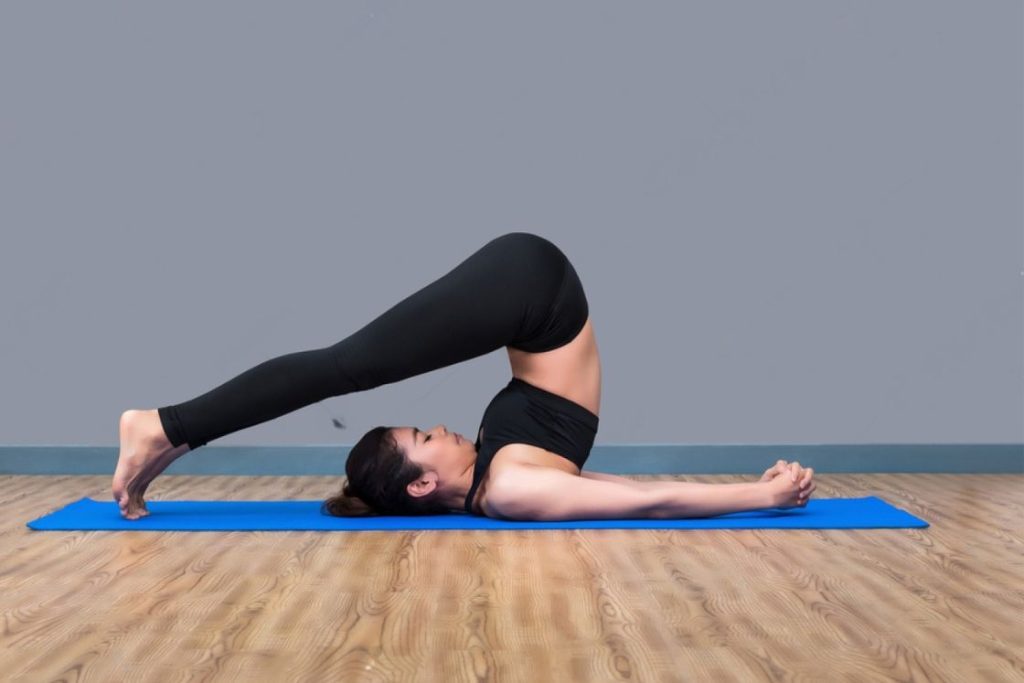
This inversion promotes blood flow to the brain and face, nourishing the skin and enhancing cognitive functions. Additionally, it stimulates the thyroid gland, which plays a pivotal role in metabolic health and aging.
6. Seated Forward Bend (Paschimottanasana)
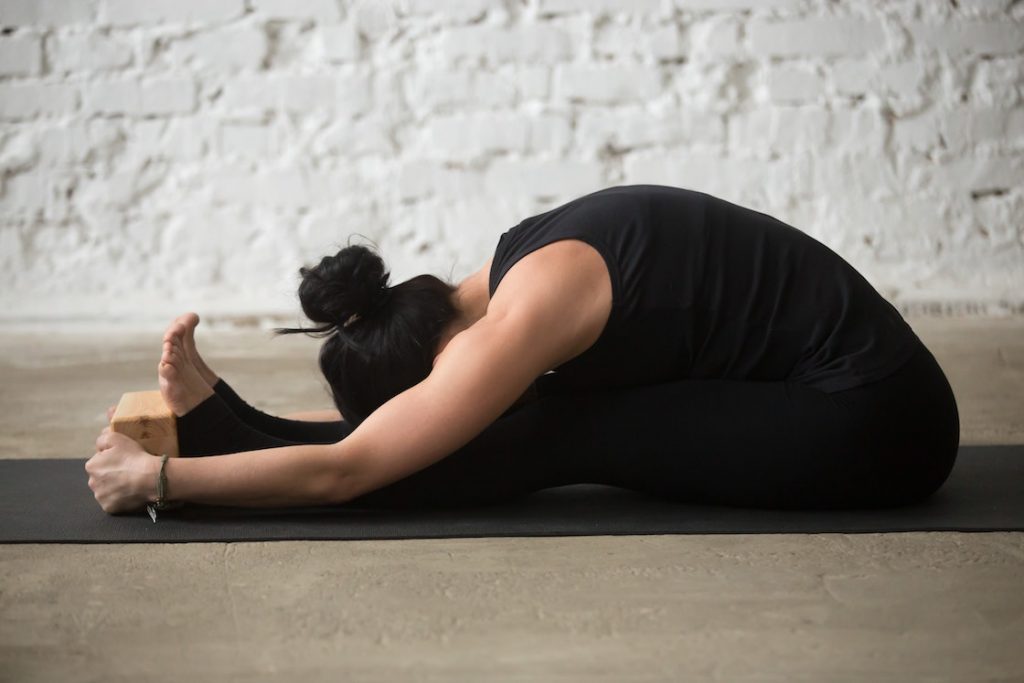
A deep stretch for the entire backside of the body, this pose alleviates stress and fatigue. It’s beneficial for the nervous system and promotes a sense of calm and relaxation, combatting the wear and tear of daily life.
7. Bridge Pose (Setu Bandha Sarvangasana)
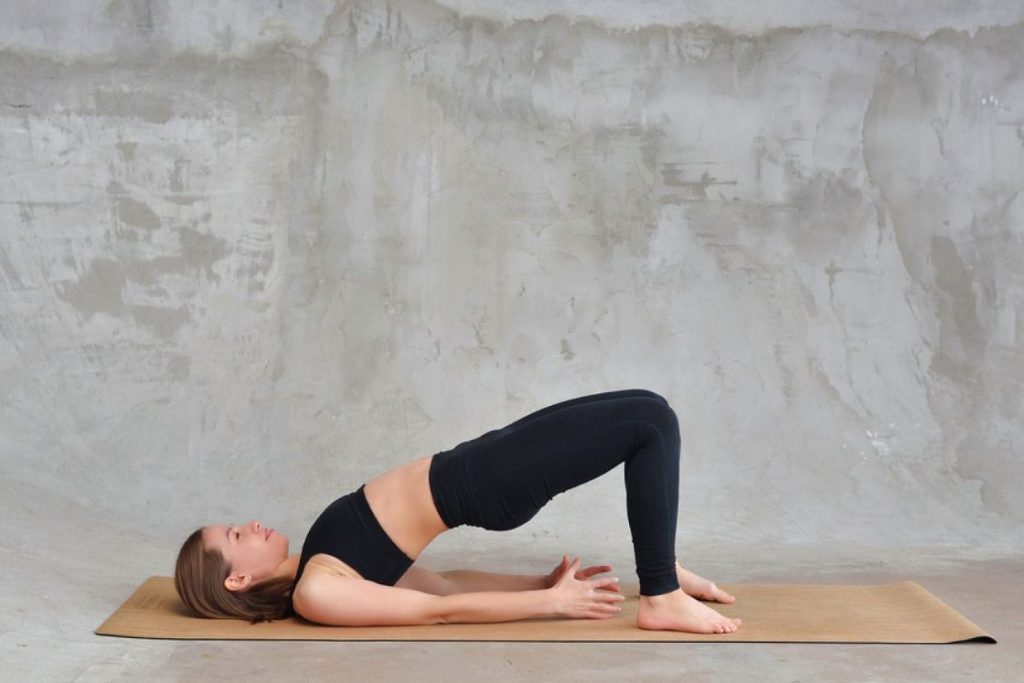
This backbend strengthens the back muscles, ensuring a youthful posture. It also stimulates the thyroid gland and can help in balancing hormones, pivotal in the aging process.
8. Corpse Pose (Savasana)
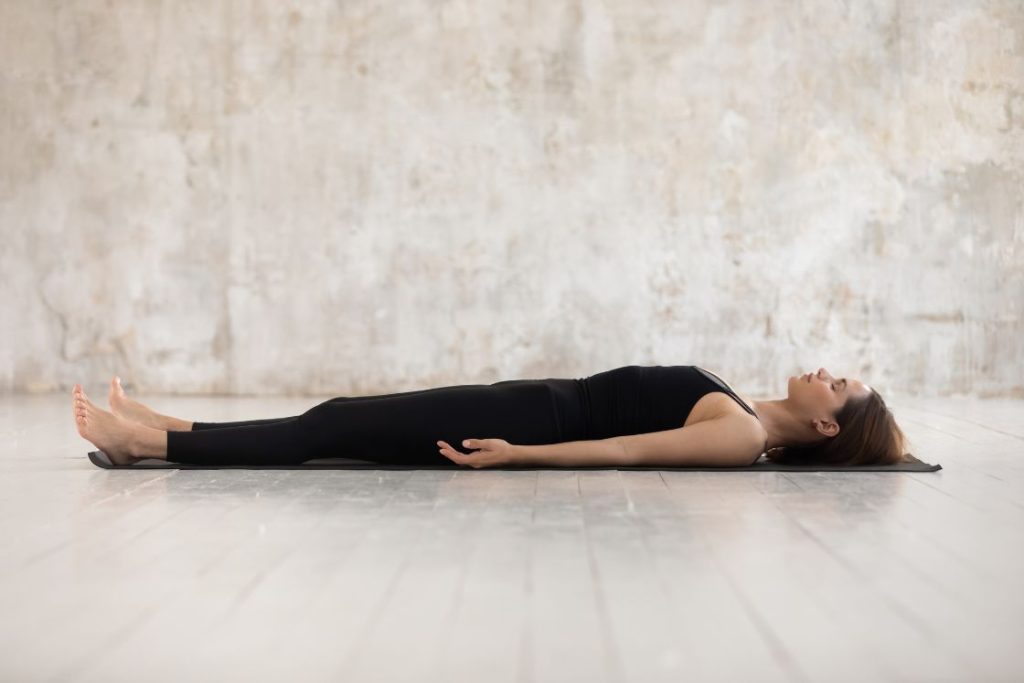
Although it seems simple, the Corpse Pose is a deep relaxation technique. By practicing stillness and mindful breathing, it helps in reducing stress, relaxing the muscles, and promoting cellular repair.
Regularly incorporating these poses into your yoga routine can offer multi-faceted benefits. While they contribute to physical strength, flexibility, and posture, they also work wonders on a cellular level, promoting rejuvenation and slowing the aging process. With consistency, one can harness the age-defying benefits of yoga and radiate both inner and outer youthfulness.
Yogic Tips to Increase Telomere Length and Reverse Aging
The science of yoga offers profound wisdom on holistic well-being, and recent research suggests it might also play a role in influencing our telomeres, the protective caps at the ends of our chromosomes. Telomere length is emerging as an important marker of our biological age. Let’s delve into some yogic practices that can potentially enhance telomere length and reverse the signs of aging.
1. Regular Asana Practice:
Committing to a daily routine of yoga postures can do wonders. Yoga poses increase blood circulation, ensuring that nutrients reach every cell, promoting their health. This, in turn, can support telomere maintenance.
2. Pranayama (Breathing Techniques):
Yogic breathing exercises, like Anulom Vilom and Bhastrika, help in enhancing the oxygen supply to cells. Increased oxygenation reduces oxidative stress, which has been linked to telomere shortening.
3. Meditation:
Daily meditation sessions, even if brief, can have profound impacts. Meditation reduces cortisol levels, a stress hormone that, when elevated, can impact telomere length. Practices like mindfulness and transcendental meditation foster a deep sense of calm and balance.
4. Dietary Awareness:
In yoga, the concept of “Ahara” or right food is emphasized. Consuming a balanced, plant-based diet rich in antioxidants can protect our cells, including telomeres, from oxidative damage. Including foods rich in Vitamin C, E, and folate is especially beneficial.
5. Yama and Niyama:
These foundational ethical precepts of yoga emphasize principles like truth, non-violence, contentment, and self-discipline. Adhering to these principles can reduce life stressors, indirectly benefiting telomere health.
6. Adequate Sleep:
Yoga recognizes the importance of restorative rest. Practices like Yoga Nidra can ensure deep relaxation and sound sleep. Adequate rest is vital for cellular repair and maintenance, which can positively influence telomeres.
7. Embrace Aparigraha (Non-attachment):
One of the Yamas, Aparigraha, teaches non-attachment or letting go. By reducing our attachment to materialistic pursuits or outcomes, we can lower our stress levels, fostering a conducive environment for cellular health.
8. Positive Affirmations:
Mantras and affirmations, an integral part of yogic practices, instill positive beliefs and emotions. Positive psychological states have been shown to influence telomere length favorably.
9. Community Engagement:
Yoga places importance on Sangha, or community. Engaging in group practices or being part of a supportive community can foster positive emotions and reduce feelings of isolation, both beneficial for telomere health.
Conclusion | Can Yoga Reverse Aging?
In our journey to uncover the deep connection between yoga and the aging process, we have explored the science behind telomeres, cellular aging, and practices rooted in yogic philosophy. At the intersection of ancient wisdom and modern science, an important question remains: Can yoga really reverse aging?
The profound wisdom of yoga, coupled with contemporary research, suggests a compelling answer. Through a consistent yoga practice, we not only improve our physical flexibility and strength, but also create an environment in which our cells can thrive. The potential effects of yoga on telomere length, a critical marker of cellular aging, suggest that yoga helps preserve our biological youth.
Pranayama, meditation, and the ethical principles embedded in yoga offer a holistic approach to well-being. By managing stress, promoting positive emotions, and building a sense of community, yoga can counteract some of the most powerful accelerators of the aging process.
However, it’s essential to recognize that yoga is not a magic potion for eternal youth. Instead, it provides us with tools to age gracefully, with vitality and a sense of purpose. The true essence of yoga lies in its ability to harmonize the mind, body, and spirit, ensuring that even as time progresses, we remain balanced, centered, and brimming with life.
In essence, while yoga might not halt the passage of time, it empowers us to embrace each moment with renewed vigor, clarity, and holistic health. In this light, yoga indeed offers a profound path to age not just with longevity, but with quality and grace.
Additional FAQs Related to Anti-aging Benefits from Yogic Traditions
If your query is related to anti-aging benefits of yoga is not covered in this article or included in this FAQs section, then feel free to contact our certified yoga instructors and get your queries solved. Or, Simply drop us a comment and we will reply!
1. Does Yoga help anti-aging?
Yes, yoga supports anti-aging by enhancing physical flexibility, reducing stress levels, and promoting better blood circulation, which together contribute to a youthful vitality and appearance.
2. Which Yoga is best for anti-aging?
Various yoga styles offer anti-aging benefits. However, Hatha and Kundalini yoga, with their combined focus on physical postures, breathing, and meditation, are often lauded for holistic well-being and anti-aging effects.
3. Can yoga slow down aging?
Absolutely. Regular yoga practice can potentially reduce oxidative stress, boost mental clarity, and improve overall health, thereby slowing down certain aging processes.
4. Can yoga make you younger?
While yoga cannot reverse chronological age, its practice can improve posture, skin health, and mental vibrancy, helping individuals feel and appear more youthful.
5. Can Yoga regenerate cells?
Direct cell regeneration from yoga isn’t scientifically proven. However, yoga can improve cellular health and function by reducing oxidative damage and stress.
6. How yoga makes you look younger?
Yoga aids in enhancing circulation, reducing facial tension, and promoting relaxation. These factors contribute to healthier skin, better posture, and a radiant, youthful glow.
7. Does meditation affect cellular aging?
Some studies suggest that meditation can support the maintenance of telomere length, which is vital for cellular health and longevity, potentially slowing cellular aging.
8. Does pranayama slow aging?
Pranayama, the art of yogic breathing, can enhance lung capacity, reduce stress, and improve cellular oxygenation, offering potential anti-aging benefits.
9. How does yoga add years to your life?
Through stress reduction, improved cardiovascular health, enhanced flexibility, and mental balance, yoga can contribute to an overall healthier lifestyle, potentially leading to increased longevity.
10. Does face yoga prevent aging?
Face yoga exercises can improve facial muscle tone and skin elasticity, potentially reducing the appearance of wrinkles and giving the face a more youthful look.
11. What hormones are released during yoga?
Yoga stimulates the release of beneficial hormones like endorphins, serotonin, and oxytocin. Additionally, it can help regulate and reduce stress hormones like cortisol.
12. How does yoga affect connective tissue?
Yoga poses stretch and strengthen connective tissues, enhancing their flexibility and resilience. This can aid in preventing injuries and maintaining joint health.
13. Is Kapalbhati anti-aging?
Kapalbhati, a breathing technique, is believed to rejuvenate and detoxify the body, promoting clearer skin and enhanced vitality, which can contribute to an anti-aging effect.
14. Does yoga improve collagen?
While there isn’t direct evidence linking yoga to collagen production, the practice enhances blood flow and overall skin health, which may indirectly support collagen maintenance.
15. Does yoga tighten skin?
Yoga improves circulation and muscle tone. While it may not directly tighten the skin, the overall enhancement of muscle tone and health can give a firmer appearance.
16.Does Ashwagandha lengthen telomeres?
Some preliminary research suggests that Ashwagandha may have a positive effect on telomere length. However, more comprehensive studies are needed to confirm this effect.




